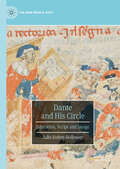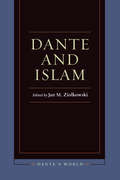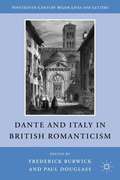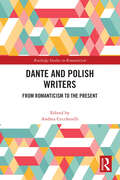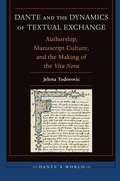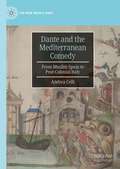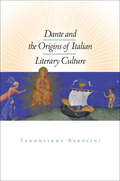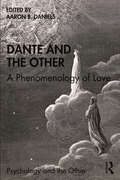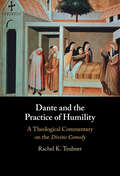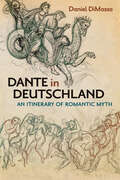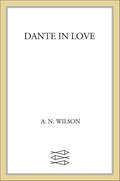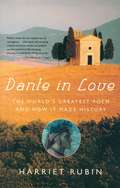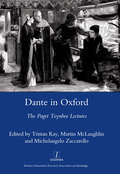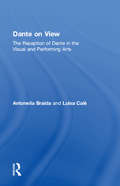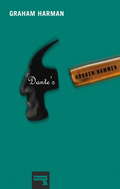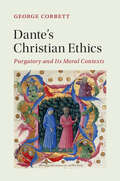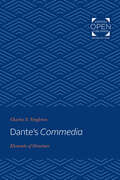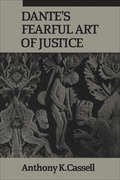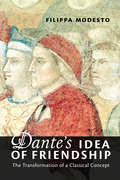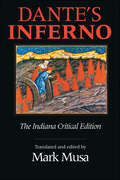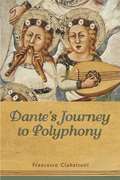- Table View
- List View
Dante and His Circle: Education, Script and Image (The New Middle Ages)
by Julia Bolton HollowayIn this book, Julia Bolton Holloway makes use of primary materials in documents, manuscripts and stone monuments in Florence, to place Dante's literary career in its rich context. Dante and His Circle discusses the encyclopaedic multicultural education in classical literature, law, ethics, rhetoric, diplomacy, poetry, music and cosmology Brunetto Latino gave to Guido Cavalcante, Dante Alighieri and Francesco da Barberino. Bolton Holloway traces Latino’s use of Arabic methods he had learned at the Court of Alfonso X el Sabio in Spain in 1260. Next Latino dictates his 'Rettorica', 'Tesoretto' and 'Tesoro' in Italian to his students, following the Sicilian Vespers, the manuscripts of their circle later coming to be re-edited, illustrated and published by Dante's fellow student, Francesco da Barberino, who survived them all and who likewise copied Alfonsine methods for producing the 'Danti del Cento' manuscripts of the 'Commedia'. The book ends by discussing Dante's Decolonialism. Each chapter provides Study Questions for further research.
Dante and Islam (Dante's World: Historicizing Literary Cultures of the Due and Trecento)
by Jan M. ZiolkowskiDante put Muhammad in one of the lowest circles of Hell. At the same time, the medieval Christian poet placed several Islamic philosophers much more honorably in Limbo. Furthermore, it has long been suggested that for much of the basic framework of the Divine Comedy Dante was indebted to apocryphal traditions about a “night journey” taken by Muhammad.Dante scholars have increasingly returned to the question of Islam to explore the often surprising encounters among religious traditions that the Middle Ages afforded. This collection of essays works through what was known of the Qur’an and of Islamic philosophy and science in Dante’s day and explores the bases for Dante’s images of Muhammad and Ali. It further compels us to look at key instances of engagement among Muslims, Jews, and Christians.
Dante and Italy in British Romanticism
by Frederick Burwick Paul DouglassFrom the artistic practice of improvisation to the politics of nationalism, the essays in this volume break new ground and significantly extend our understanding of the relations between British and Italian culture in its analysis of the reception of Dante and Italian literature in British Romanticism.
Dante and Polish Writers: From Romanticism to the Present (Routledge Studies in Romanticism)
by Andrea CeccherelliDante and Polish Writers: From Romanticism to the Present explores the phenomenon of Polish Danteism from a hermeneutic perspective. The chapters shed light on a series of “encounters” of eminent Polish writers with Dante and the Divine Comedy, resulting in original interpretations, creative reworkings, and a wealth of intertextual references testifying to a dialogue that has always been – and still is - alive, not excluding antagonism and bitter controversy. The contributors are all scholars of Polish literature with comparative expertise, teaching in Italian and Polish universities, which ensures a consistently focused point of view on the receptive context and the ways in which it is affected by the confrontation with Dante. The hermeneutic horizon ranges from the Inferno-like reading of the inhuman lands with which history abounds, to the metaphysical yearning underlying Dante’s “poetics of transhumanizing,” to recent perspectives related to the posthuman and storytelling.
Dante and the Dynamics of Textual Exchange: Authorship, Manuscript Culture, and the Making of the 'Vita Nova' (Dante's World: Historicizing Literary Cultures of the Due and Trecento)
by Jelena TodorovićDante and the Dynamics of Textual Exchange is the first book-length study to explore the question of poetry and genre in Dante’s Vita Nova (ca. 1292–1294). In paying particular attention to complex and multifaceted interactions between different cultures in Italy in the thirteenth century, this study illuminates the multicultural and plurilinguistic society transitioning from the feudal court to the modern city-state, advanced by the rising mercantile class. Working at the intersection of textual, material, and cultural elements, this study complements the current state of scholarship by providing information and answers informed by an in-depth analysis of the manuscript culture and its role in the birth and development of European vernacular traditions. Furthermore, Dante and the Dynamics of Textual Exchange expands the literature’s understanding of the dynamics between a text and its material support by looking at this relationship within a broader framework of intercultural exchange, which suggests an increased dynamics and fluidity between cultures.
Dante and the Mediterranean Comedy: From Muslim Spain to Post-Colonial Italy (The New Middle Ages)
by Andrea CelliIn recent decades the concept of Mediterranean has been cited with increasing frequency in relation to the study of medieval literatures. And yet, in what sense would Dante’s Comedy be ‘Mediterranean’? Is it because of its Greek-Arabic and Islamic sources? Dante and the Mediterranean Comedy analyzes the ideological function of references to the sea in the study of the Comedy undertaken by Enrico Cerulli, a scholar of Somali-Ethiopian languages, and a colonial governor of ‘Italian East Africa.’ Then it presents novel lines of inquiry on the reception and appropriation of the poem, such as the presence of Islamic sources in early commentaries of the Comedy, and cross-cultural allusions to Dante’s Hell in some graffiti on the walls of the Spanish Inquisition prison in Palermo. The image of the Mediterranean that seeps through the poem and through the history of its circulation is vivid yet hardly idyllic.
Dante and the Origins of Italian Literary Culture
by Teodolinda BaroliniIn this book, Teodolinda Barolini explores the sources of Italian literary culture in the figures of its lyric poets and its “three crowns”: Dante, Petrarch, and Boccaccio. Barolini views the origins of Italian literary culture through four prisms: the ideological/philosophical, the intertextual/multicultural, the structural/formal, and the social.The essays in the first section treat the ideology of love and desire from the early lyric tradition to the Inferno and its antecedents in philosophy and theology. In the second, Barolini focuses on Dante as heir to both the Christian visionary and the classical pagan traditions (with emphasis on Vergil and Ovid). The essays in the third part analyze the narrative character of Dante’s Vita nuova, Petrarch’s lyric sequence, and Boccaccio’s Decameron. Barolini also looks at the cultural implications of the editorial history of Dante’s rime and at what sparso versus organico spells in the Italian imaginary. In the section on gender, she argues that the didactic texts intended for women’s use and instruction, as explored by Guittone, Dante, and Boccaccio—but not by Petrarch—were more progressive than the courtly style for which the Italian tradition is celebrated.Moving from the lyric origins of the Divine Comedy in “Dante and the Lyric Past” to Petrarch’s regressive stance on gender in “Notes toward a Gendered History of Italian Literature”—and encompassing, among others, Giacomo da Lentini, Guido Cavalcanti, and Guittone d’Arezzo—these sixteen essays by one of our leading critics frame the literary culture of thirteenth-and fourteenth-century Italy in fresh, illuminating ways that will prove useful and instructive to students and scholars alike.
Dante and the Other: A Phenomenology of Love (Psychology and the Other)
by Aaron B. DanielsDante and the Other brings together noted and emerging Dante scholars with theologians, philosophers, psychoanalysts, and psychotherapists, bridging the Florentine’s premodern world to today’s postmodern context. Exploring how alterity has become a potent symbol in religion, philosophy, politics, and culture, this book will be of interest to many related fields. The book offers a thorough foundation in approaching Dante as proto-phenomenologist. It includes an informative review of literature, historical insight into Dante’s poetics-toward-ineffability as alternative to modern scientism, a foray into science fiction, existential elaborations, phenomenological analyses of Inferno’s Canto I, and applications to psychotherapy and qualitative research. It also contains a poem from an imagined Virgil retiring in Limbo, and a meditation on Dante’s complicated relationship to homosexuality. Dante and the Other presents the mystical passion of apophatic spirituality, the millennia-spanning Augustinianism of radical orthodoxy, Levinas, Heidegger, and many others—all driven by Dante’s Labors of Love. It is essential reading for Dante scholars, as well as readers interested in his works.
Dante and the Practice of Humility: A Theological Commentary on the Divine Comedy
by Rachel K. TeubnerIn this book, Rachel Teubner offers an exploration of humility in Dante's Divine Comedy, arguing that the poem is an ascetical exercise concerned with training its author gradually in the practice of humility, rather than being a reflection of authorial hubris. A contribution to recent scholarship that considers the poem to be a work of self-examination, her volume investigates its scriptural, literary, and liturgical sources, also offering fresh feminist perspectives on its theological challenges. Teubner demonstrates how the poetry of the Comedy is theologically significant, focusing especially on the poem's definition of humility as ethically and artistically meaningful. Interrogating the text canto by canto, she also reveals how contemporary tools of literary analysis can offer new insights into its meaning. Undergraduate and novice readers will benefit from this companion, just as theologians and scholars of medieval religion will be introduced to a growing body of scholarship exploring Dante's religious thought.
Dante in Context
by Zygmunt G. BarańskiIn the past seven centuries Dante has become world renowned, with his works translated into multiple languages and read by people of all ages and cultural backgrounds. This volume brings together interdisciplinary essays by leading, international scholars to provide a comprehensive account of the historical, cultural and intellectual context in which Dante lived and worked: from the economic, social and political scene to the feel of daily life; from education and religion to the administration of justice; from medicine to philosophy and science; from classical antiquity to popular culture; and from the dramatic transformation of urban spaces to the explosion of visual arts and music. This book, while locating Dante in relation to each of these topics, offers readers a clear and reliable idea of what life was like for Dante as an outstanding poet and intellectual in the Italy of the late Middle Ages.
Dante in Deutschland: An Itinerary of Romantic Myth (New Studies in the Age of Goethe)
by Daniel DiMassaAround the turn of the nineteenth century, no task seemed more urgent to German Romantics than the creation of a new mythology. It would unite modern poets and grant them common ground, and bring philosophers and the Volk closer together. But what would a new mythology look like? Only one model sufficed, according to Friedrich Schlegel: Dante’s Divine Comedy. Through reading and juxtaposing canonical and obscure texts, Dante in Deutschland shows how Dante’s work shaped the development of German Romanticism; it argues, all the while, that the weight of Dante’s influence induced a Romantic preoccupation with authority: Who was authorized to create a mythology? This question—traced across texts by Schelling, Novalis, and Goethe—begets a Neo-Romantic fixation with Dantean authority in the mythic ventures of Gerhart Hauptmann, Rudolf Borchardt, and Stefan George. Only in Thomas Mann’s novels, DiMassa asserts, is the Romantics’ Dantean project ultimately demythologized.
Dante in Love: A Biography
by A. N. WilsonFor William Butler Yeats, Dante Alighieri was "the chief imagination of Christendom." For T. S. Eliot, he was of supreme importance, both as poet and philosopher. Coleridge championed his introduction to an English readership. Tennyson based his poem "Ulysses" on lines from the Inferno. Byron chastised an "Ungrateful Florence" for exiling Dante. The DivineComedy resonates across five hundred years of our literary canon. In Dante in Love, A. N. Wilson presents a glittering study of an artist and his world, arguing that without an understanding of medieval Florence, it is impossible to grasp the meaning of Dante's great poem. He explains how the Italian states were at that time locked into violent feuds, mirrored in the ferocious competition between the Holy Roman Empire and the Papacy. He shows how Dante's preoccupations with classical mythology, numerology, and the great Christian philosophers inform every line of the Comedy. Dante in Love also explores the enigma of the man who never wrote about the mother of his children, yet immortalized the mysterious Beatrice whom he barely knew. With a biographer's eye for detail and a novelist's comprehension of the creative process, A. N. Wilson paints a masterful portrait of Dante Alighieri and unlocks one of the seminal works of literature for a new generation of readers.
Dante in Love: The World's Greatest Poem and How It Made History
by Harriet RubinDante in Love is the story of the most famous journey in literature. Dante Alighieri, exiled from his home in Florence, a fugitive from justice, followed a road in 1302 that took him first to the labyrinths of hell then up the healing mountain of purgatory, and finally to paradise. He found a vision and a language that made him immortal. Author Harriet Rubin follows Dante's path along the old Jubilee routes that linked monasteries and all roads to Rome. It is a path followed by generations of seekers -- from T. S. Eliot, Sigmund Freud, Primo Levi, to Bruce Springsteen. After the poet fled Rome for Siena he walked along the upper Arno, past La Verna, to Bibiena, to Cesena, and to the Po plain. During his nineteen-year journey Dante wrote his "unfathomable heart song," as Thomas Carlyle called The Divine Comedy, a poem that explores the three states of the psyche. Eliot, a lifelong student of the Comedy, said, "Dante and Shakespeare divide the modern world between them, there is no third. "Dante in Love tells the story of the High Middle Ages, a time during which the artist Giotto was the first to paint the sky blue, Francis of Assisi discovered knowledge in humility and the great doctors of the church mapped the soul and stood back to admire their cathedrals. Dante's medieval world gave birth to the foundation of modern art, faith and commerce. Dante and his fellow artists were trying to decode God's art and in so doing unravel the double helix of creativity. We meet the painters, church builders and pilgrims from Florence to Rome to Venice and Verona who made the roads the center of the medieval world. Following Dante's route, we are inspired to undertake journeys of discovering ourselves. In the vein of Brunelleschi's Dome, Galileo's Daughter and Wittgenstein's Poker, Dante in Love is a worldly and spiritual travelogue of the poet's travels and the journey of creativity that produced the greatest poem ever written.
Dante in Oxford: The Paget Toynbee Lectures 1995-2003 (Oxford Modern Languages And Literature Monographs)
by Tristan KayThe Paget Toynbee lectures on Dante have taken place in Oxford since the mid-1990s. Named after the great medieval scholar of the first half of the twentieth century, they have been delivered by the major Dante experts of our time. This volume gathers together twelve of the most significant lectures, given by internationally renowned scholars such as Zygmunt Baranski, John Barnes, Lino Leonardi, Emilio Pasquini, Michelangelo Picone, Jonathan Usher and the late Peter Armour. The topics range from key questions such as Dante, Ovid and the poetry of exile, to ground-breaking work on obscenity in the Divine Comedy .
Dante on View: The Reception of Dante in the Visual and Performing Arts
by Antonella Braida Luisa CalèDante on View opens an important new dimension in Dante studies: for the first time a collection of essays analyses the presence of the Italian Medieval poet Dante Alighieri in the visual and performing arts from the Middle Ages to the present day. The essays in this volume explore the image of Dante emerging in medieval illuminated manuscripts and later ideological and nostalgic uses of the poet. The volume also demonstrates the rich diversity of projects inspired by the Commedia both as an overall polysemic structure and as a repository of scenes, which generate a repertoire for painters, actors and film-makers. In its original multimediality, Dante's Commedia stimulates the performance of readers and artists working in different media from manuscript to stage, from ballet to hyperinstruments, from film to television. Through such a variety of media, the reception of Dante in the visual and performing arts enriches our understanding of the poet and of the arts represented at key moments of formal and structural change in the European cultural world.
Dante the Lyric and Ethical Poet: Dante Lirico E Etico
by Zygmunt G. Bara'nski"This book presents the proceedings of the fifth meeting of the International Dante Seminar. As with previous volumes, the proceedings also include a carefully edited account of the extensive discussions which followed the presentations. The papers, given by some of the leading international scholars of the poet - from Italy, the UK and the USA - address four major topics of particular concern to present-day Dante studies: Dante as a lyric poet; Dante as an ethical poet; Dante and the Eclogues; and Dante in nineteenth-century Britain. These topics reflect both areas which are currently the subject of heated critical debate (several editions of the lyric poems are in preparation, and the ethical dimension of Dantes works is very much under discussion) and areas which are long overdue a reassessment (Dantes remarkable revival of Latin pastoral poetry, and the extraordinary British contribution to Dante studies in the nineteenth century). As this set of conference proceedings makes clear, in Dante and in his legacy, ethics and poetry are inseparable. The contributors include Paola Allegretti, Michael Caesar, Paolo Falzone, Manuele Gragnolati, Claudio Giunta, Claire Honess, Robin Kirkpatrick, John Lindon, Lino Pertile, Justin Steinberg, Claudia Villa, and Diego Zancani."
Dante's Broken Hammer
by Graham HarmanIn this book the founder of object-oriented philosophy transforms one of the classic poets of the Western canon, Dante Alighieri, into an edgy stimulus for contemporary continental thought. It is well known that Dante's poetic works interpret love as the moving force of the universe: as embodied in his muse Beatrice from La Vita Nuova onward, as well as the much holier persons inhabiting Paradiso. Likewise, if love is the ultimate form of sincerity, it is easy to interpret the Inferno as a brilliant counterpoint of anti-sincerity, governed by fraud and blasphemy along with the innocuous form of fraud known as humor (strangely absent from all parts of Dante's cosmos other than hell). In turn, the middle ground of Purgatorio is where Harman locates Dante's clearest theory of sincerity. Yet this is only the beginning. For while Dante provides a suitable background for the metaphysics of commitment found in such later thinkers as Pascal, Kierkegaard, Sartre, and Badiou, he also provides even more important resources for overcoming two centuries of philosophy shaped by Immanuel Kant.From the Trade Paperback edition.
Dante's Christian Ethics: Purgatory and its Moral Contexts (Cambridge Studies in Medieval Literature #110)
by George CorbettThis book is a major re-appraisal of the Commedia as originally envisaged by Dante: as a work of ethics. Privileging the ethical, Corbett increases our appreciation of Dante's eschatological innovations and literary genius. Drawing upon a wider range of moral contexts than in previous studies, this book presents an overarching account of the complex ordering and political programme of Dante's afterlife. Balancing close readings with a lucid overview of Dante's Commedia as an ethical and political manifesto, Corbett cogently approaches the poem through its moral structure. The book provides detailed interpretations of three particularly significant sins - pride, sloth, and avarice - and the three terraces of Purgatory devoted to them. While scholars register Dante's explicit confession of pride, the volume uncovers Dante's implicit confession of sloth and prodigality (the opposing subvice of avarice) through Statius, his moral cypher.
Dante's Commedia: Elements of Structure
by Charles S. SingletonOriginally published in 1977. This book contains four essays by Professor Charles Singleton: "Allegory," "Symbolism," "The Pattern at the Center," and "The Substance of Things Seen." These four essays treat four dimensions of meaning essential to understanding the substance and special texture of the poetry of the Divine Comedy. One might speak of "facets" or "aspects" of meaning if such terms did not suggest surface reflections dependent on the way a work (as a jewel) is turned for inspection. But for Singleton, each dimension has a depth that reaches to the core and substance of Dante's poetry, so they are, in Singleton's view, elements of its structure.
Dante's Divine Comedy: A Biography
by Joseph LuzziThe life and times of Dante&’s soaring poetic allegory of the soul&’s redemptive journey toward GodWritten during his exile from Florence in the early 1300s, Dante Alighieri&’s Divine Comedy describes the poet&’s travels through hell, purgatory, and paradise, exploring the state of the human soul after death. His poema sacro, sacred poem, profoundly influenced Renaissance writers and artists such as Giovanni Boccaccio and Sandro Botticelli and was venerated by modern critics including Erich Auerbach and Harold Bloom. Dante&’s &“Divine Comedy&” narrates the remarkable reception of Dante&’s masterpiece, one of the most consequential religious books ever written.Tracing the many afterlives of Dante&’s epic poem, Joseph Luzzi shows how it left its mark on the work of such legendary authors as John Milton, Mary Shelley, and James Joyce while serving as a source of inspiration for writers like Primo Levi and Antonio Gramsci as they faced the most extreme forms of political oppression. He charts how the dialogue between religious and secular ideas in The Divine Comedy has shaped issues ranging from changing conceptions of women&’s identity and debates about censorship to the role of canonical literature in popular culture.An intimate portrait of a work that has challenged and inspired generations of readers, Dante&’s &“Divine Comedy&” reveals how Dante&’s strikingly original and controversial vision of the afterlife can help us define our spiritual beliefs, better understand ourselves, and navigate the complexities of modern life.
Dante's Epic Journeys
by David ThompsonOriginally published in 1974. This book on comparative literature represents the first extended attempt to relate Dante's major allegorical mode to classical and medieval interpretations of epic poetry rather than to patristic biblical exegesis. Dante's Epic Journeys is also the first comprehensive explanation of Dante's enigmatic Ulysses. Thompson strives to shed new light not only on Dante's allegory—and thus upon the whole troubled question of exactly what an allegory was thought to be—but also on the intricate relationship between poet and poem and between Dante's spiritual journeys and his written representation of those itineraries.
Dante's Fearful Art of Justice
by Anthony CassellDante's Fearful Art of Justice deals primarily with the symbolic significance of 'the state of souls after death' in various episodes of the Inferno, the first canticle of Dante's Divina Commedia. The fruitlessness of the Auerbach-Singleton approach to the poem is demonstrated by Professor Cassell's investigations, which are based on the belief that Dante used both the theological system of fourfold allegory and the preconfiguration-fulfilment pattern of history found in the Old and New Testaments. The author first deals with the history of contrapassum, 'just retribution,' as it appeared in philosophy and theology, and describes Dante's use of historical and artistic figuration, both classical and Christian. It is central to Cassell's aim to show how Dante believed that his portrayal of the damned revealed the justice of God. Critics have believed that the relation of sin to the suffering of the shades in Hell was tenuous or even arbitrary in many cases. Cassell shows, through a close examination of Dante's assimilation of the Classics (and their medieval interpretations), or patristics, and of traditional iconography, that there is an intimate metaphorical and artistic aptness in the poet's representation. Cassell relies at some points on art history, and thirty-four illustrations of frescoes, statuary, and illuminations from paleo-Christian times to the fourteenth century are therefore included.This volume will be of particular interest to medieval specialists, historians of the Renaissance and Reformation periods, and those concerned with European literature.
Dante's Idea of Friendship
by Filippa ModestoIn the ancient world, friendship was a virtue of great philosophical importance. Aristotle wrote extensively about it, as did Cicero. Their conception of friendship as a relationship based on reason and virtue was transformed by Christianity into a connection based on the mutual love of an individual and God.In Dante's Idea of Friendship, Filippa Modesto offers sharp readings of the Commedia, Vita Nuova, and Convivio that demonstrate Dante's interest in that theme. Drawing on a lucid and wide-ranging examination of the literature on friendship, she shows how he weaved together the contradictory classical and the Christian concepts of friendship into a harmonious synthesis in which friendship became a handmaiden to salvation and happiness. A fresh, perceptive interpretation of Dante's works, Dante's Idea of Friendship will engage medievalists, classicists, and scholars of friendship throughout the ages.
Dante's Inferno, The Indiana Critical Edition (Indiana Masterpiece Editions)
by Dante Alighieri“Adds to the body of contemporary versions of the Inferno . . . [includes] detailed textual notes . . . [and] critical essays by the leading Dante scholars.” —Library JournalThis new critical edition, including Mark Musa’s classic translation, provides students with a clear, readable verse translation accompanied by ten innovative interpretations of Dante's masterpiece.
Dante's Journey to Polyphony
by Francesco CiabattoniIn Dante's Journey to Polyphony, Francesco Ciabattoni's erudite analysis sheds light on Dante's use of music in the Divine Comedy. Following the work's musical evolution, Ciabattoni moves from the cacophony of Inferno through the monophony of Purgatory, to the polyphony of Paradise and argues that Dante's use of sacred songs constitutes a thoroughly planned system. Particular types of music accompany the pilgrim's itinerary and reflect medieval theories regarding sound and the sacred. Combining musicological and philological scholarship, this book analyzes Dante's use of music in conjunction with the form and content of his verse, resulting in a cross-discipline analysis also touching on Italian Studies, Medieval Studies, and Cultural History. After moving from infernal din to heavenly harmony, Ciabattoni's final section addresses the music of the spheres, a theory that enjoyed great diffusion among the early middle ages, inspiring poets and philosophers for centuries.
